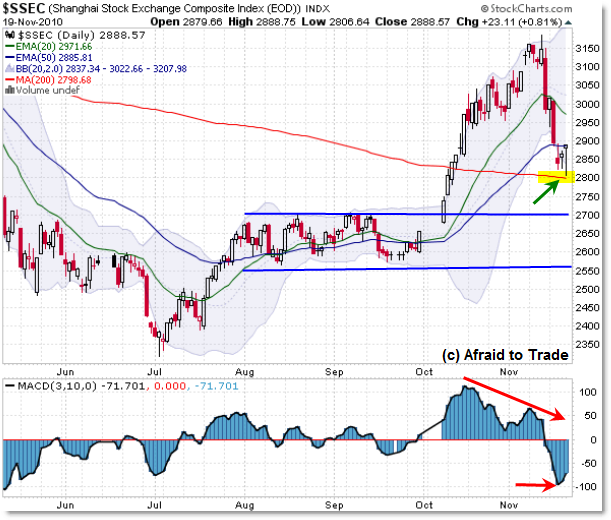Viewing the Key Support and Resistance Levels to Watch on China Shanghai
I’ve had a couple of requests lately to take a look at China’s Shanghai index ($SSEC) and indeed there’s something interesting going on in the charts.
Let’s take a look at the confluence support and resistance levels on both the Weekly and Daily charts and set-up the next likely plays depending on how price acts at those levels.

The chart above is the Weekly Structure, wherein the most important immediate information is the confluence resistance at 3,200 and confluence support at 2,800.
Let’s start first with the resistance.
Keeping it as simple as possible, we have a horizontal price trendline from the prior April 2010 high at 3,200 which also intersects with the 200 week SMA, currently positioned at 3,209 (call it 3,200).
Ok – so that held as key resistance last week and hinted at a possible decline which occurred, and now the attention turns to the confluence EMA support at 2,800.
That’s because price rallied off this level this week – it’s the 20w EMA at 2,807 and the 50w EMA at 2,805. Again – let’s call it 2,800 even for reference to traders.
That sets up the weekly chart structure with the following “IF/THENs”:
IF confluence support holds at 2,800, THEN look to play a potential move back up to the resistance at 3,200.
And of course the alternates:
IF support FAILS at 2,800, look to play a downside break to lower support which might include the September low at 2,600 or even the 2010 low at 2,400.
And… IF confluence resistance should break, look to position long on a move up to prior resistance either at 3,300 or 3,400.
With that in mind, let’s drop down to the daily frame for a tighter reign on price:

Here’s a cool little trick – notice how price pushed up to the 3,200 high last week and then stalled with reversal candles at the 3,150 area. A negative momentum divergence formed at the upper Bollinger Band, which sets up an aggressive trade (short). Price then fell to the lower EMAs in a successful short trade.
That’s what happened on the daily chart, but you could have been better armed to short – if that was your goal – by watching the key 3,200 confluence resistance area (price and moving average) via the Weekly Chart above.
That alone is a good lesson in integrating two timeframes.
Anyway, what we have here is the 200 SMA which might hold as support at the 2,800 level – so far price is bouncing off this important SMA.
Beneath that we have two price levels to watch as potential support – being 2,700 and 2,550 – which are just simple pure price levels from prior zones.
Short-term traders can trade price pivots (bounces) around these key levels, while intermediate-term traders might want to wait for these levels to break or hold before positioning or repositioning if need be.
If this is the beginning of a new price leg down, look for a retest up to the 3,000 level to occur, fail to break above 3,000, and then the new leg down to form. As such, watching if that retracement materializes, and if so, what happens at 3,000, will be key.
Otherwise, keep focused on the Weekly levels mentioned above.
Corey Rosenbloom, CMT
Afraid to Trade.com
Follow Corey on Twitter: http://twitter.com/afraidtotrade

I notice that Sam Weinstein recommends using the 30MA on weekly charts, but you use 20 and 50. Is this because in gives more insights than a simple 30MA? Do you think it is sufficient to use 30MA?
Good question, Gus!
Lots of traders have their favorite settings for MAs – even different MAs for different timeframes – but I've gravitated over the years to the 20 EMA and 50 EMA as my favorites. I think what I'm trying to go for is a short-term and then intermediate term average, and for me, those do the job. The 30 EMA probably combines those.
Main idea is to see if the market/price reacts to the averages, as sometimes major EMA price tests create self-fulfilling prophecies.